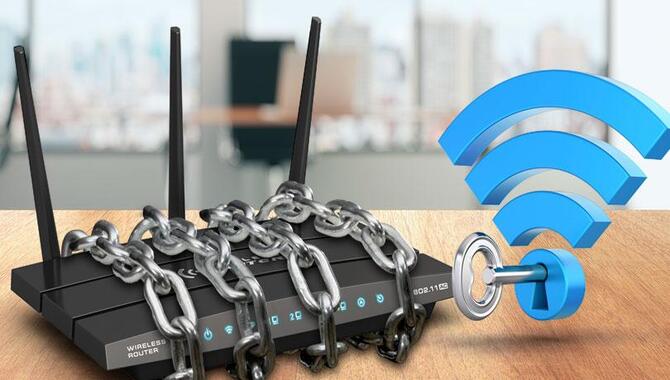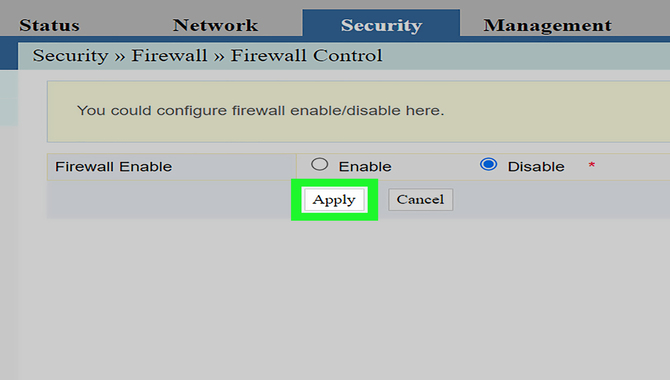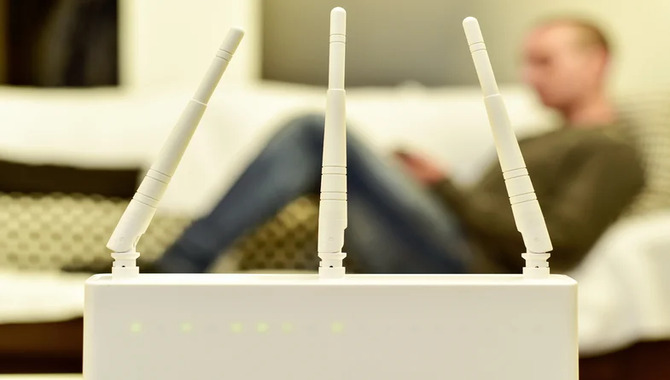It is essential to secure your Wi-Fi network in order to protect your personal information and maintain the privacy of your online activities.
With the advancement of technology, cybercriminals have become more sophisticated in their methods of hacking into networks and stealing sensitive data. In today’s digital age, securing your Wi-Fi network is of utmost importance. From protecting your personal information to preventing unauthorized access, a secure Wi-Fi network is essential for maintaining your online privacy.
Here we will discuss why you need to secure your Wi-Fi network and provide you with practical tips on how to secure your Wi-Fi network to do so. Don’t let hackers compromise your internet connection – take action now to safeguard your Wi-Fi network and protect yourself from potential cyber threats.

Why You Need To Secure Your Wifi Network

Securing your WiFi network is vital for various reasons. One primary motive is safeguarding your personal data and sensitive information from cybercriminals. By implementing strong security measures, you can protect your information from being accessed or misused by hackers.
Another crucial aspect of securing your Wi-Fi network is preventing unauthorized access. By keeping your network secure, you can avoid potential cyber attacks and ensure the privacy of your online activities. Additionally, securing your network helps maintain a stable and reliable internet connection. It prevents bandwidth theft, improving the overall performance of your Wi-Fi network.
9 Steps On How To Secure Your Wi-Fi Network

To ensure the security of your Wi-Fi network, it’s essential to take certain precautions. By adhering to these guidelines, you can safeguard your personal data and prevent unauthorized access. Make sure to change your router’s default username and password, as this is a common target for hackers.
Additionally, enabling network encryption, creating a strong password, and disabling remote access are vital steps in securing your network. Regularly updating your router’s firmware and enabling a firewall will further fortify your network against potential threats. Remember, protecting your Wi-Fi network is crucial in today’s digital age. Here are 9 Steps on how to secure your Wi-Fi network.
1. Change Your Router’s Default Password

Enhancing the security of your Wi-Fi network involves various steps, one of which is changing the default password for your router. By doing so, you can effectively reduce the risk of unauthorized access to your network. Since default passwords are easily accessible to hackers, it is crucial to select a strong and unique password that combines letters, numbers, and special characters.
This helps protect your network from potential attacks. Additionally, make sure to regularly update your router’s firmware to stay protected against any security vulnerabilities that may arise. It’s important to prioritize the security of your Wi-Fi network to safeguard your personal information and maintain a safe online environment.
2. Change Your Wi-Fi Network Password
Changing the password for your Wi-Fi network is a crucial step in ensuring the security of your wireless connection. By choosing a strong and unique password, you can safeguard your network against potential hackers and unauthorized access attempts. It is advisable to avoid using common words or easily guessable information when creating your Wi-Fi network password.
Additionally, enabling WPA2 encryption on your router is essential to encrypt and secure the data transmitted over your WiFi network. Taking the extra step of hiding your Wi-Fi network’s SSID (network name) can further enhance security by making it more challenging for unauthorized users to discover and connect to your network. Regularly updating your router’s firmware is also vital in order to benefit from the latest security patches and enhancements.
3. Use The Latest Wi-Fi Encryption

Enhancing the security of your Wi-Fi network is essential to protect against cybercriminals. By changing the encryption on your wireless network to the latest Wi-Fi protocols like WPA3 or WPA2, you can safeguard your personal data and ensure secure internet access.
To update your network’s encryption, access your router’s settings through a web browser and navigate to the wireless settings section. Select the desired encryption protocol, such as WPA3 or WPA2, and set a strong password consisting of a combination of upper and lowercase letters, numbers, and special characters.
Avoid using easily guessable passwords to further strengthen your network security. With these measures in place, you can enjoy a safe and secure Wi-Fi connection without compromising your online privacy.
4. Update Your Wifi Router Firmware
Regularly updating your WiFi router firmware is essential for maintaining the security of your network. By installing the latest firmware updates, you can ensure that your router has the necessary security patches and bug fixes, protecting against potential vulnerabilities. To update your router’s firmware, visit the manufacturer’s website or navigate to the router’s settings page.
Look for available updates and follow the provided instructions to install them. Consider enabling automatic updates for added convenience. By keeping your router’s firmware up to date, you can enhance the security of your WiFi network, safeguarding your personal data and protecting against cyber threats.
5. Create A Guest Wifi Network

To enhance the security of your Wi-Fi network, consider creating a guest network. This separate network not only allows friends and family to connect without accessing your personal or sensitive information but also provides an additional layer of security.
You can effectively prevent unauthorized access by setting a strong password for the guest network. It is crucial to regularly change the passwords for both your main network and guest network to further enhance security. Additionally, enabling additional security measures such as MAC address filtering or disabling SSID broadcasting can provide added protection against potential threats.
6. Disable Remote Access
To enhance the security of your Wi-Fi network, it’s vital to disable remote access. With remote access disabled, you can thwart unauthorized individuals from gaining control of your network. This feature enables outsiders to connect to your router, potentially jeopardizing your Wi-Fi.
Prevent such risks by accessing your router’s settings and disabling remote management or administration. Moreover, fortify your network by selecting a robust, distinctive password for your router. Regulate your security by updating your router’s firmware regularly, as it ensures up-to-date security patches and safeguards.
7. Turn On Your Router’s Firewall

Enhancing the security of your Wi-Fi network is crucial for protecting your personal data and devices. One of the key steps in achieving this is by turning on your router’s firewall. By activating this feature, you create a protective barrier that shields your network from potential vulnerabilities and cyber threats.
The firewall acts as a shield that blocks unauthorized access and prevents suspicious activities from compromising your network.
To enable the firewall, access your router’s settings and activate this option. It’s important to set a strong password for your router’s admin interface to keep it secure. Additionally, regularly updating your router’s firmware ensures that you have the latest security patches in place, further strengthening your network’s defenses.
8. Protecting Your Online Identity With A VPN

When it comes to securing your Wi-Fi network, one of the most effective tools you can utilize is a VPN, or Virtual Private Network. By using a VPN, you can protect your online identity and ensure your privacy and anonymity. With a VPN, your internet traffic is routed through a secure and encrypted connection, making it nearly impossible for hackers or eavesdroppers to intercept your data.
This is especially important when using public Wi-Fi networks, as it safeguards your personal information from potential threats. Moreover, a VPN provides an extra layer of security by hiding your IP address and protecting your sensitive data from unauthorized access. By incorporating a VPN into your online routine, you can rest easy knowing that your Wi-Fi network is secure and your personal information is safe from prying eyes.
9. Disable WPS

Disabling WPS is a crucial step in enhancing the security of your Wi-Fi network. By disabling WPS (Wi-Fi Protected Setup), you can prevent potential hackers from gaining unauthorized access to your network. Ensure that you disable WPS to safeguard your router from brute-force attacks and maintain the integrity of your network.
To turn off WPS, access your router’s settings through your web browser and locate the Wi-Fi or Wireless section. Look for the option to disable WPS and apply the changes. Remember to employ a strong and unique Wi-Fi password, enable encryption, and regularly update your router’s firmware to fortify your network against cyber threats. Safeguarding your Wi-Fi network is the best way to protect your sensitive information and secure a safe online experience.
How To Secure Wifi Routers

To secure your Wi-Fi network, it is crucial to take steps to protect your Wi-Fi router. Begin by changing the default login credentials of your router to prevent unauthorized access. It is essential to enable network encryption, such as WPA2 or WPA3, to safeguard the data transmitted over the wireless network. It’s also important to disable remote management and guest networks if they’re not in use.
Regularly updating your router’s firmware is vital to address any security vulnerabilities. Ensure that you use strong and unique passwords for both your Wi-Fi network and router admin access. Additionally, consider enabling MAC address filtering to only allow specific devices to connect to your network.
Change The Default Username And Password
To enhance the security of your Wi-Fi network, it is crucial to change the default username and password provided by your router manufacturer. Default credentials are commonly known and can make it easier for hackers to gain unauthorized access to your network.
Protect your network by selecting a strong and unique password that includes a combination of uppercase and lowercase letters, numbers, and special characters. Avoid using common passwords or personal information that can be easily guessed or obtained. Regularly updating your router’s firmware ensures you have the latest security patches and features. Disabling remote management of your router prevents unauthorized access from outside your network.
Enable Encryption
To safeguard your Wi-Fi network, enabling encryption is crucial. Encryption protects your network from unauthorized access by encrypting the data transmitted between devices and the router. The most commonly used encryption, WPA2, provides a high level of security.
Ensure you choose a strong password for your Wi-Fi network to enhance security and prevent hackers from gaining access. Additionally, updating the firmware of your router regularly is essential. Firmware updates fix vulnerabilities and strengthen your network’s security features. Keeping your router up to date with the latest security patches enhances protection against cyber threats.
Update Your Router’s Firmware
Upgrading the firmware of your router is pivotal in safeguarding the integrity of your home Wi-Fi network. By regularly updating your router’s firmware, you enhance its security features and stay one step ahead of potential cyber threats. Firmware updates often come with essential security patches, subsequently fortifying your network against hackers and malware.
To update your router’s firmware, visit the manufacturer’s website and follow their instructions meticulously for a seamless installation process. Additionally, consider enabling automatic updates to keep your router up-to-date with the latest advancements in network security. Remember to perform firmware updates concurrently with other security protocols, such as configuring strong passwords and enabling encryption.
Conclusion
securing your Wi-Fi network is essential to protect your personal information and prevent unauthorized access. By following the steps mentioned in how to secure your Wi-Fi network, you can significantly enhance the security of your Wi-Fi network and reduce the risk of cyber attacks.
Remember, a secure Wi-Fi network not only safeguards your data but also ensures a safer online experience for everyone in your household. Take the necessary steps today to secure your Wi-Fi network and enjoy peace of mind. Remember, a secure network not only protects your data but also provides peace of mind. Take action today and implement these security measures to keep your Wi-Fi network safe from potential threats.
Frequently Asked Questions
1.How Do I Make My Wi-Fi Private?
Ans: To secure your Wi-Fi network, customize the default username and password of your router, enable WPA2 encryption, either disable guest networks or set a strong password for them, and keep your router’s firmware up-to-date to address any security risks.
2.What Is The Most Secure Option For Wi-Fi Network?
Ans: The most secure option for a Wi-Fi network is WPA3 (Wi-Fi Protected Access 3). It provides stronger encryption, better protection against hacking and unauthorized access. To enhance security, use a strong, unique password and regularly update your router’s firmware for the latest security patches.
3.How To Secure Your Home Wifi Network Looking To Improve Your Wifi Security?
Ans: To enhance the security of your home WiFi network, change the default login credentials for your router, enable encryption like WPA2, disable remote management access, and keep your router’s firmware updated with the latest security patches. These measures help safeguard against unauthorized access and potential threats.
4.What Can You Do To Minimize The Risks To Your Wireless Network?
Ans: To minimize risks to your wireless network, change the default admin username and password for your Wi-Fi router, enable WPA2 or WPA3 encryption, regularly update the router’s firmware for security patches, and disable remote management and guest networks if not necessary. These measures help protect against potential vulnerabilities.
5.What Are The Best Ways To Secure Your Wi-Fi Network?
Ans: To secure your Wi-Fi network, change the default SSID and password, enable WPA2 or WPA3 encryption, disable remote management and guest access if unnecessary, and regularly update your router’s firmware for security patches. These measures help protect your network from unauthorized access and potential vulnerabilities.

Leave a Reply